Think You Know Which Dog Breeds Attack The Most? The Truth May Surprise You
When you purchase through links on our site, we may earn a commission. Here’s how it works.
Yes, Pit Bull–type dogs appear most often in attack reports. What’s less obvious is how often those reports involve misidentified or mixed-breed dogs.
Table of Contents
Here are the breeds most frequently named in attack statistics — and why the numbers don’t tell the whole story.
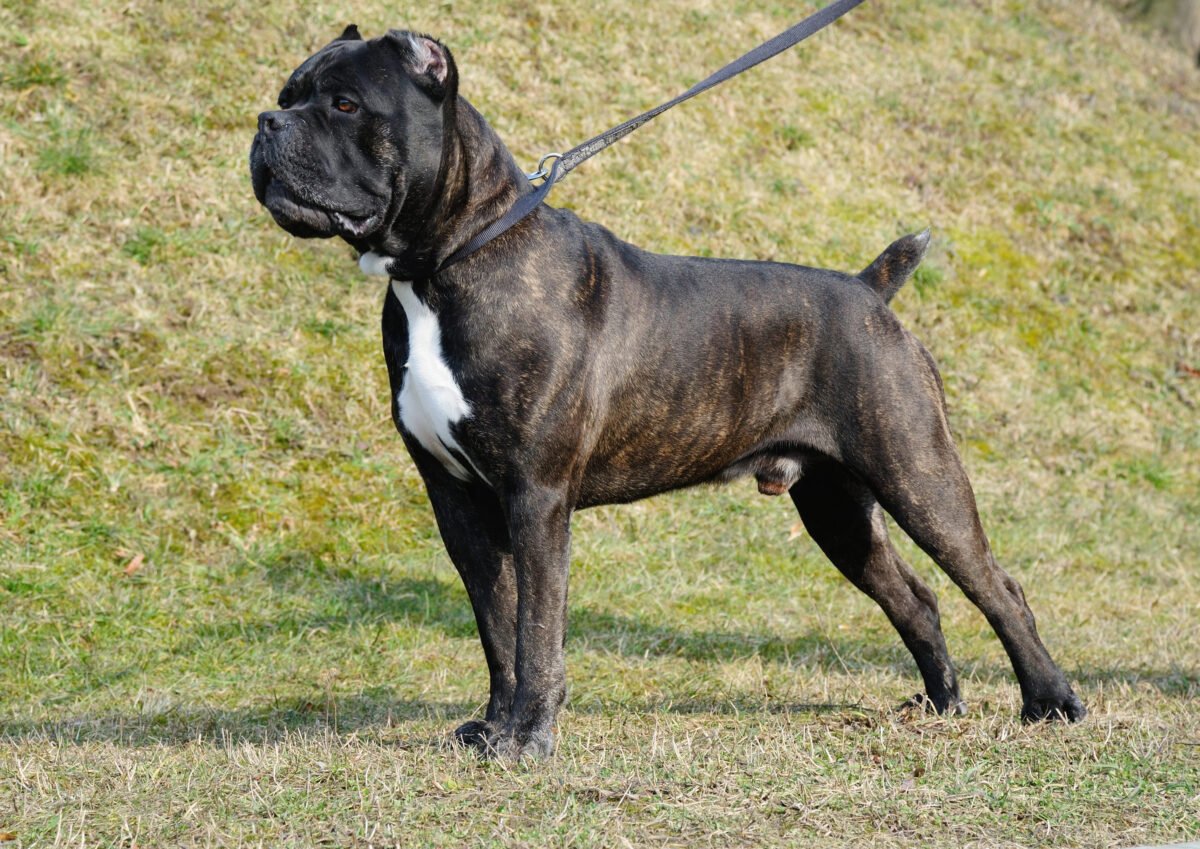
3 Breeds Most Often Named In Attack Reports
Most dog attack data focuses on serious or medically significant incidents rather than minor bites. That means the numbers below represent the most severe cases — the attacks that lead to hospital visits, trauma evaluations, or official reports.
Pit Bull–type dogs and Rottweilers appear most often in severe or fatal attacks, with German Shepherds close behind.
These patterns don’t prove that certain breeds are inherently dangerous. They reflect a mix of owner behavior, breed popularity, and how dogs are identified in the first place.
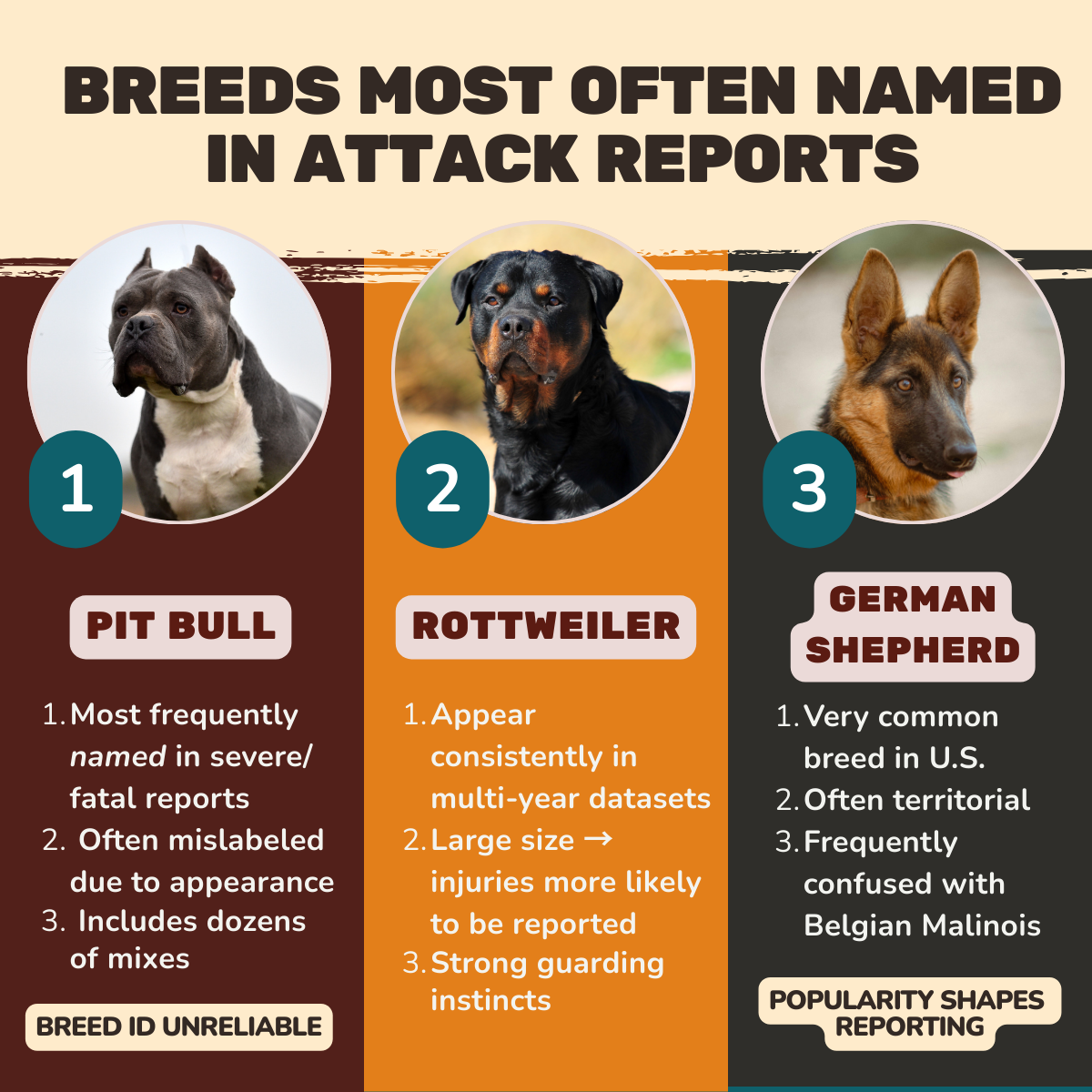
1. Pit Bull–Type Dogs
Pit Bull–type dogs appear more often than any other group in fatal bite studies and severe injury reports. But the label covers several breeds plus many mixed-breed dogs who simply look similar.
CDC data from 1979–1996 linked 60 fatalities to Pit Bull–type dogs, nearly double the next breed. Other studies show similar patterns across pediatric bites and severe trauma cases.
The Pit Bull’s broad head and muscular build also tend to cause more severe injuries when bites do occur. A 2020 study in the Journal of Experimental Biology confirmed that large brachycephalic dogs — including Pit Bulls, Rottweilers, and Bulldogs — have a mechanical advantage in bite force.
Why “Pit Bull” Is A Moving Target
The term “pit bull” is often based on appearance rather than genetics. Even professionals regularly misidentify dogs, and DNA tests frequently contradict visual guesses.
Takeaway: Pit bull–type dogs are the most commonly reported in incidents, but inconsistent labeling, popularity, and owner factors make the numbers murkier than they appear.
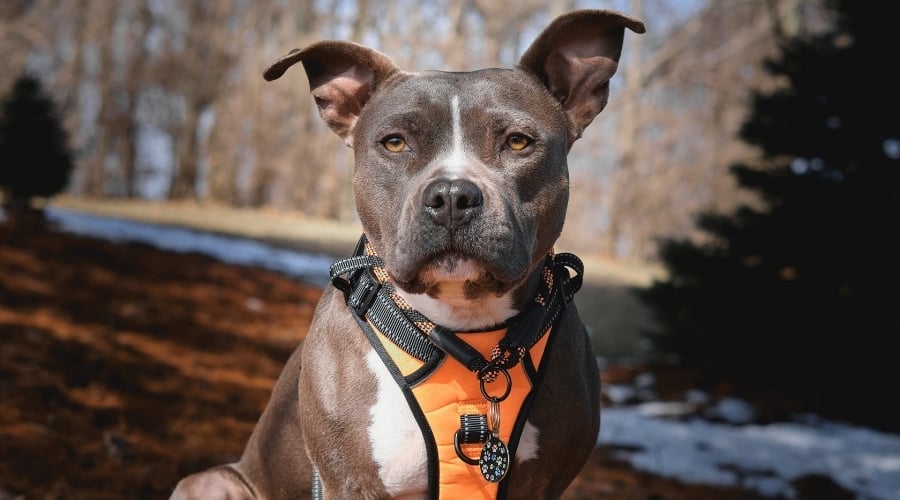
2. Rottweilers
The Rottweiler breed consistently appear just behind Pit Bulls in fatality data and dog attacks by breed.
Rottweilers consistently follow Pit Bull–type dogs in fatality data. CDC reviews documented 29 Rottweiler-related deaths across 17 years.
An AVMA review covering 20 years of fatalities found that Pit Bulls and Rottweilers accounted for more than half of reported fatalities. This happened even though at least 25 breeds were represented in the data.
Their robust build and guarding instincts contribute to injury severity. As with Pit Bulls, however, their presence in the data may reflect both owner preference and breed popularity during specific decades.
Important Note: Owner influence is one of the biggest drivers behind attack numbers. Breeds chosen for guarding, protection, or “status” are more likely to be poorly trained or improperly managed.
3. German Shepherds
German Shepherds frequently appear in bite studies due to their strength and protective instincts. In CDC fatality data, they ranked third with 19 cases.
A pediatric study of nearly 15,000 bites found German Shepherds second only to Pit Bulls in child-involved incidents. Studies also show they appear more often in cases involving younger victims.
Their guarding drive makes them excellent working dogs. But without consistent training and socialization, that same trait can increase risk.
Takeaway: German Shepherds show up in attack data because they’re large, strong, popular, and widely used as protective dogs — not because the breed is inherently unsafe. The more dogs of a certain type there are, the more opportunities for bites or serious incidents.
Which Dogs Attack Strangers, Owners & Other Dogs Most Often?
A study on canine aggression published in Applied Animal Behaviour Science found that certain breeds are more likely to direct aggression toward specific targets — strangers, their own owners, or other dogs.
These patterns don’t predict how any individual dog will behave, but they do reveal how genetics, training, fear, and environment shape risk.
5 Breeds Most Aggressive Toward Strangers
Stranger-directed aggression is usually driven by fear, anxiety, or territorial behavior. Small breeds dominate this category because many react defensively when startled, handled abruptly, or approached too quickly.

| Breed | Stranger Aggression Score | Notes on Behavior |
|---|---|---|
| Dachshund | 20.6 | High stranger aggression, often fear-based |
| Chihuahua | 16.1 | Defensive snaps and nips, very reactive |
| Australian Cattle Dog | 9.6 | Protective herder with territorial instincts |
| Border Collie | 8.0 | Herding drive may translate into nipping at strangers |
| Beagle | 7.9 | Friendly but prone to barking/snapping when insecure |
5 Breeds Most Aggressive Toward Owners/Family
Owner-directed aggression is almost always rooted in fear, pain, or resource-guarding — not dominance. Poor boundaries, unpredictable handling, or chronic stress can also push anxious dogs into reactive behavior.

| Breed | Owner Aggression Score | Notes on Behavior |
|---|---|---|
| Beagle | 7.9 | Surprisingly high rates of owner-directed aggression; may snap when guarding food or toys |
| Dachshund | 5.9 | Known for bold personalities; may bite if handled roughly or when feeling threatened |
| Cocker Spaniel | 5.6 | Higher reports of aggression in certain show lines; may redirect frustration onto owners |
| Chihuahua | 5.4 | Strong attachment to owners can lead to defensive nipping when stressed or startled |
| Jack Russell Terrier | 3.8 | High-energy and reactive; can redirect aggression onto family members if overstimulated |
5 Breeds Most Aggressive Toward Other Dogs
Dog-to-dog aggression is influenced by socialization, prey drive, same-sex reactivity, and territorial behavior. These incidents rarely match human-directed aggression patterns and often reflect a breed’s historical purpose.

| Breed | Dog-Directed Aggression Score | Notes on Behavior |
|---|---|---|
| Akita | 29.3 | Extremely high dog-directed aggression; often intolerant of unfamiliar dogs |
| Pit Bull–Type Dogs | 22.0 | More prone to aggression toward other dogs than toward strangers; selective socialization is critical |
| Jack Russell Terrier | 21.8 | Feisty, bold, and often reactive with other dogs despite small size |
| Australian Cattle Dog | 20.6 | Strong herding and guarding instincts make them more likely to challenge other dogs |
| Chihuahua | 17.9 | Frequently reactive toward other dogs, often out of fear or defensiveness |
Why These Lists Don’t Predict Individual Behavior
Aggression is complex and heavily shaped by training, early socialization, environment, and owner behavior. Breed tendencies explain patterns in data, but they do not determine the behavior of any specific dog.
Why These Dogs Attack (And Why It’s Not Just Breed)
Dog attacks aren’t random. A dog’s history, size, and purpose often shape how it responds when threatened or excited.
1. Size Factor
Smaller dogs may seem harmless, but they’re often more reactive because the world feels bigger and more threatening to them. Many snap defensively, especially when handled roughly or picked up without warning.

Chihuahuas, Dachshunds, and other small breeds are frequently reported for fear-based aggression. Larger dogs show aggression less often, but their size makes any bite far more dangerous.
Quick Stat: Only about 0.01% of the 4.5 million annual dog bites in the U.S. require hospitalization, but larger breeds make up a disproportionate share of severe injuries.
2. Breed Purpose & Instincts
Many dogs were bred for jobs — guarding, herding, hunting, or protection — and those instincts still influence behavior today. A herding dog may nip running kids, while a guarding breed may react strongly to strangers at the door.
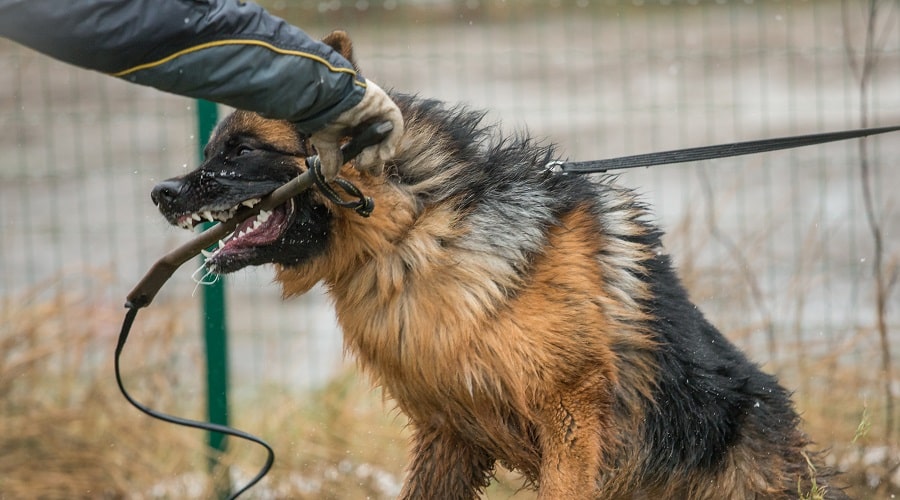
Instincts don’t guarantee aggression, but unmanaged or misunderstood behavior can increase risk. Training and structure help channel these drives safely.
When Police Dogs Attack
Police K-9s cause some of the most severe bites recorded in the U.S., and multiple studies highlight their impact. A 2024 ACLU review across 37 California agencies found K-9s frequently inflicted serious injuries on people who posed no threat.
Another study found police dog bites were more severe than typical pet bites and often involved the head, neck, or torso. In Los Angeles, nearly 800 K-9 bite cases revealed that half of the victims required hospitalization, with high rates of nerve, vascular, and fracture injuries.
Policy changes reduced some incidents, but K-9 bites remain far more severe than standard dog bites. Their training, strength, and targeting behavior make their injuries uniquely serious.
3. Human Influence (The Biggest Factor)
Most severe dog bites stem from human behavior, not the dog’s genetics. Lack of socialization, neglect, isolation, or poor training dramatically increases the risk of aggression.

Dogs raised in safe, stable, well-managed homes rarely show dangerous behavior. Environment, structure, and owner decisions have more influence on bite risk than breed alone.
A nine-year JAVMA review of fatal dog attacks identified clear human-linked patterns. The most common factors included:
- Unsupervised interactions
- Intact (unneutered) male dogs
- Vulnerable victims (children or elderly adults)
- Dogs kept isolated or unsocialized
- Owners with a history of neglect or abuse
The good news: Every major risk factor in that study is preventable through responsible ownership.
Dog Bites On The Job
More than 6,000 postal workers were attacked by dogs in 2024, according to the U.S. Postal Service. USPS stresses that owner responsibility — secure enclosures, basic training, and controlled greetings — is the strongest predictor of whether a dog will bite.
Offensive vs Defensive Aggression In Dogs
Not all aggression looks the same. Some dogs move toward a threat with confidence, while others react out of fear and try to protect themselves. Understanding the difference helps you read a dog’s intent long before a bite happens.
- Offensive aggression is forward, assertive behavior meant to control, intimidate, or drive something away.
- Defensive aggression is fear-based and happens when a dog feels cornered or unsafe.
Both can be dangerous, but the body language leading up to each looks very different.

Most Attacks Are Preventable
Many dogs show early stress signals long before aggression appears. Recognizing these signs — especially in fearful dogs — can help you avoid triggering a defensive bite.
Early warning signals to watch for:
- Whale eye (white of the eye showing)
- Lip licking or repeated tongue flicks
- Yawning outside of a tired context
- Turning the head away
- Freezing or sudden stillness
- Tail tucked or held low
- Backing up or leaning away
- Ears pinned back
If you see these signals, give the dog space, remain calm, and avoid direct eye contact. Interrupting the cycle here is the key to preventing most bites.
Why So Much Dog Bite Data Is Misleading
When a dog bite makes the news, one of the first details reported is the breed of the dog. The assumption is that if we know the breed, we can identify the cause — and perhaps prevent future attacks.
But research shows that’s a shaky foundation. In most reports, a dog’s breed is guessed based on appearance, not pedigree or DNA.
Even trained professionals disagree on visual breed identification. Studies consistently show that mislabeling is common, yet these labels often make their way into official reports and news headlines as if they’re fact.
The most comprehensive study to date, published in JAVMA, found that in 82% of fatal dog bite cases, the breed of the dog could not be reliably confirmed. In the small portion of cases where breed was identified, more than 20 different breeds and mixes were involved.
In other words, much of the bite data circulating online — including older studies — is built on shaky foundations. When breed labels are wrong, the conclusions drawn from them become unreliable too.
What The Research Actually Says
- Fatal attacks almost always involve preventable human factors, such as lack of supervision, intact males, or dogs kept in isolation.
- “Pit Bull–type” dogs face high rates of mislabeling because the definition varies by state, shelter, and even individual observer.
- No single breed is inherently responsible for fatal dog attacks. The risk factors are broad, and they cut across all breeds and mixes.
Bottom Line: Breed identification in attack reports is unreliable at best. Focusing on breed alone doesn’t solve the problem, but prevention, training, and responsible ownership do.
The Real Numbers Behind Dog Attacks
Before diving into which breeds appear most frequently in reports, it is helpful to understand the broader context of dog bite data — who’s most at risk, where attacks occur, and how often they result in fatalities.
Dog Bites In The U.S.
- Approximately 4.5 million dog bites occur in the U.S. each year.
- Around 334,000 people are treated in emergency departments annually for dog bite–related injuries.
- During 2011–2021, 468 deaths were recorded from dog bites or related injuries — an average of 43 deaths per year.
Where & How Attacks Happen
- 80% of bites happen at home, not in public spaces.
- 77% of biting dogs belong to the victim’s family or a friend.
- From 1989–1994, fatal incidents most often involved dogs unrestrained on their owner’s property (59%), compared to 22% off-property and 18% restrained on-property.
Who’s Involved
- Intact (unneutered) male dogs are responsible for 70–76% of reported bite incidents.
- Children under 12 years old account for nearly half of all emergency visits, with the highest incidence among kids aged 5–9.
Which Breeds Are Named Most Often
In multiple studies, breeds most frequently represented in serious biting incidents include German Shepherds, mixed breeds, Pit Bull–type dogs, Rottweilers, Jack Russell Terriers, Chow Chows, Spaniels, Collies, Saint Bernards, and Labrador Retrievers.
When looking only at cases involving severe or fatal injuries, Pit Bull–type dogs are more frequently identified, though the majority of fatal cases involve unknown breeds.
Which Dogs Cause The Most Severe Injuries (The Truth About Bite Force)
If you’ve ever Googled dog bite strength, you’ve probably seen dramatic claims like “Kangal: 700 PSI!” or “This breed has the strongest bite on earth.” These charts go viral because they look impressive, but these numbers aren’t based on reliable data.

PSI Is Not Bite Strength
PSI measures pressure, not total force. A smaller contact point produces a higher PSI number even if the dog doesn’t bite any harder.
Online comparisons often show wildly inflated PSI claims because they’re based on different testing surfaces, bite angles, or equipment. This makes breed “PSI rankings” essentially meaningless.
True bite force depends on how much total mechanical power a dog can generate — not a single pressure reading from a single bite.
Bite Force Varies By Individual Dog, Not Breed
You cannot assign a single bite-force value to an entire breed. Bite strength changes based on the dog’s size, jaw shape, training, motivation, and even the equipment being used.
Two dogs of the same breed can produce completely different results. This is why experts warn against weaponizing breed-wide bite-force “stats,” because no such universal numbers exist.
What Real Science Shows: Head Shape + Mass + Jaw Mechanics
Researchers now know that skull shape and muscle architecture are major predictors of potential bite strength.
Brachycephalic or block-headed dogs have a mechanical advantage due to shorter jaws and broader muscle attachments.
Muscle size, mandible shape, and overall head mass all work together to determine the maximum force a dog could produce. In other words, the strongest biters are typically the dogs with the biggest heads, deepest jaws, and most muscle.
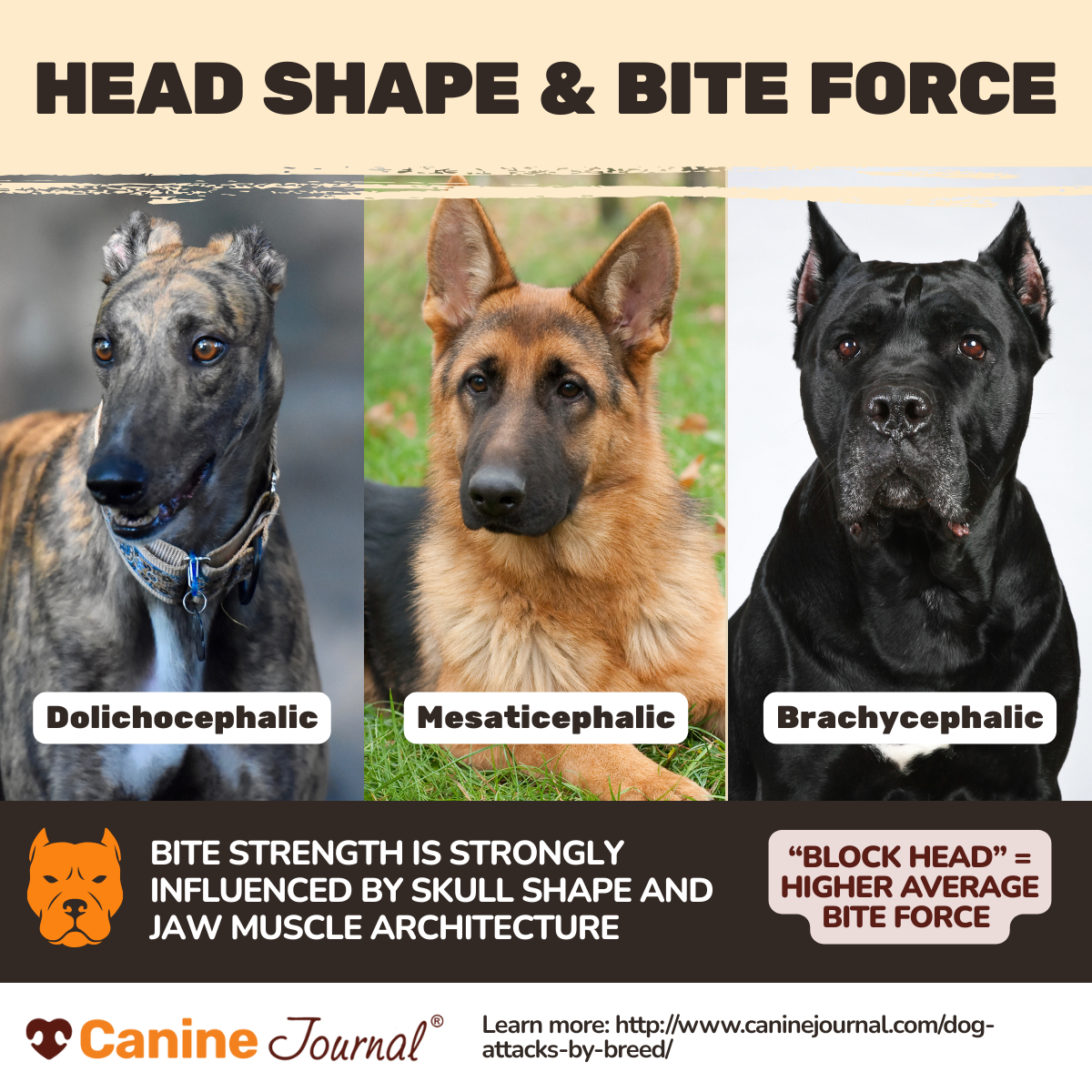
The Most Accurate Bite-Force Testing We Have
You may be wondering, “If all the PSI numbers I see online are false, what can I actually trust?” After sorting through the research, the most accurate and transparent testing I found comes from Rogue1K9, who built a custom bite-measuring sleeve and recorded force from real working dogs trained in bitework.
Instead of relying on guesses or pressure charts, this setup captured true mechanical force produced by individual dogs under controlled conditions. The data isn’t breed-wide — it reflects the strength of specific dogs — but it’s the closest we have to real, repeatable bite-force measurement.
So far, the strongest measured bites have come from large mastiff-type breeds.
Measured Bite Forces (Lbs)
- Cane Corso (Bronson) — 456 lb
- Rottweiler (Bronson) — 403 lb
- Presa Canario (Rage) — 390 lb
- Rottweiler (Pablo) — 385 lb
- Bandogge (Shadow) — 372 lb
- Cane Corso (Bolo) — 361 lb
These numbers reflect real dogs, real equipment, and real bites — not online myths or inflated PSI charts.
Watch: The video from Rogue1K9 shows the top five bite force performers in action.
Power-To-Weight Results (Who Hits Hardest For Their Size)
This metric shows how powerful a dog’s bite is compared to its body size. It doesn’t measure total bite force — it simply highlights which dogs deliver the strongest bite pound for pound.
Top performers include Bandogges, Bullherders, and Rottweilers, confirming that well-muscled, athletic dogs can deliver exceptional strength relative to their weight.
What About Breeds Not Tested?
Dogs such as Kangals, Caucasian Shepherds, and Central Asian Shepherd (Alabai) were not included in the testing. Still, their massive heads, deep jaws, and powerful musculature suggest they would likely produce strong bite forces.
Until they’re tested under identical conditions, however, any PSI or bite-force numbers for those breeds remain unknown.
What This Actually Means For Injury Severity
Large, muscular dogs with broad jaws and heavy skulls are more capable of causing severe damage when they bite. Smaller dogs bite more often, but their bites rarely require hospitalization.
This doesn’t make any breed inherently more dangerous. It simply explains why certain breeds appear more often in severe-injury data — they have the physical ability to do more damage, even if they bite less frequently overall.
Quick Takeaway: Severe injuries are driven by size, strength, and jaw mechanics — not PSI myths or “aggressive breeds.” Understanding these factors helps owners manage dogs responsibly and avoid situations where bites can occur.
Prevention Matters More Than Breed
Any dog — regardless of breed — can bite under the wrong circumstances. The strongest predictors of aggression are environmental, not genetic.

Lack of training, poor socialization, chronic stress, or leaving dogs unneutered all raise the risk of biting. Even gentle family pets may react defensively if they feel cornered, scared, or overwhelmed.
Responsible ownership is the most effective tool we have for preventing bites. Every major study on severe dog bites points to human-controlled factors as the core drivers of risk.
6 Ways To Reduce Bite Risk
- Socialize early: Give puppies positive exposure to people, sounds, and environments during their first 16 weeks so they build confidence rather than fear.
- Train consistently: Teach impulse control and reward calm behavior with positive reinforcement. Clear structure helps prevent reactive responses.
- Manage wisely: Supervise children closely, maintain secure fencing, and avoid high-stress environments — like crowded dog parks — for reactive or anxious dogs.
- Neuter when appropriate: Research shows unneutered males are significantly more likely to bite than neutered males.
- Recognize warning signs: Familiarize yourself with your dog’s body language and respect them.
- Avoiding rough play: Even the friendliest of dogs may bite during rough play or teasing.
Quick Takeaway: Breed may shape instincts, but training, socialization, and environment shape behavior. Prevention will always matter more than labels.
What Should I Do If An Aggressive Dog Approaches Me?
Most dogs give warning signs before they bite, but when those signals go unnoticed, situations can escalate quickly. Knowing how to handle an approaching aggressive dog can prevent a tense moment from turning into an attack.
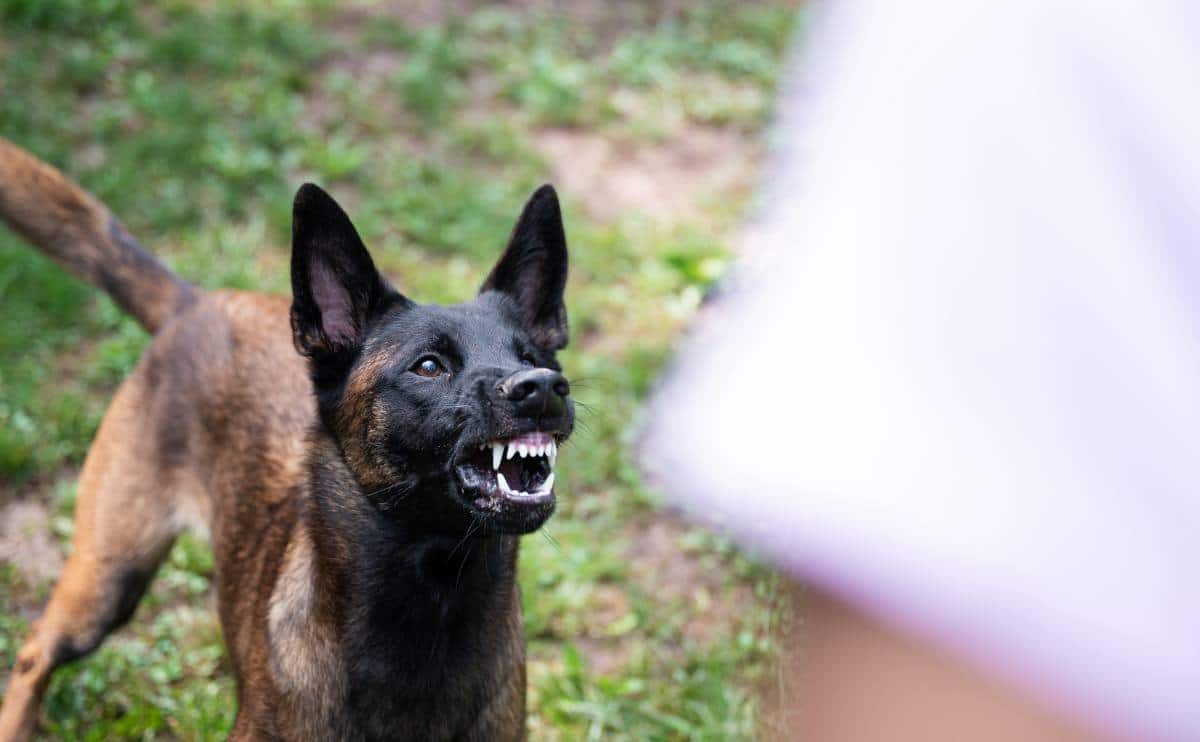
1. Stay Still & Avoid Eye Contact
Freeze in place with your arms close to your body. Dogs are less likely to chase or lunge when the “prey” stops moving.
Don’t shout, run, or stare directly at the dog. Direct eye contact can feel threatening and may escalate the situation.
2. Turn Your Body Slightly To The Side
A sideways posture looks less confrontational to dogs. It also helps you stay balanced if the dog gets closer.
Keep your face and torso angled away while still monitoring the dog with your peripheral vision.
3. Speak Softly & Move Slowly
Use a calm, low voice to reduce tension. Fast gestures, high-pitched yelling, or waving your arms can make an anxious dog more reactive.
If you need to create distance, take slow, small steps backward without turning your back.
4. Give The Dog Something To Target
If the dog lunges, place an object — a jacket, bag, backpack, or even a stick — between you and the dog. This redirects the bite away from your body.
If you fall, curl into a ball and protect your face, chest, and neck with your arms.
5. After The Incident, Report The Situation
If an unfamiliar dog charges, bites, or repeatedly shows threatening behavior, notify local animal control. This protects both the community and the dog, who may need intervention, medical care, or better management.
Quick Takeaway: Staying calm, still, and non-threatening is the safest way to de-escalate an encounter with an aggressive dog. Most bites happen when people run, shout, or panic — not because the dog was determined to attack.
Breed-Specific Laws & Bans: What Actually Works
Breed-specific legislation (BSL) restricts or bans certain breeds — usually Pit Bulls, Rottweilers, and other large guardian breeds — in an effort to reduce dog bites. More than 1,000 U.S. jurisdictions have enacted some form of BSL. View breed-specific legislation by state at BSLCensus.com.

These laws are well-intentioned, but most research shows they fail to produce meaningful results. Dog bites and fatalities do not decrease in communities with breed bans, largely because the laws target appearance instead of the behavior or conditions that cause aggression.
Visual breed identification is also unreliable, which means many dogs are regulated or removed based on looks alone. That’s why organizations like AVMA, ASPCA, and Humane World for Animals all oppose BSL and support behavior-based, breed-neutral policies instead.
Cities that have repealed BSL and shifted toward leash-law enforcement, licensing, and community education often see better long-term outcomes. Responsible ownership — not breed bans — remains the only proven path to safer neighborhoods.
Quick Takeaway: Laws that punish looks don’t prevent bites. Policies that focus on behavior, training, and accountability do.
Our Personal Experience With A Dog Attack
My son was attacked by a Chow Chow when we were walking home from school. He was 7 years old at the time and very much liked dogs.
This was an animal that lived on the same block as us, and we would walk by it and the owner regularly. We often said hello and petted the pup, with permission and supervision from the owner.
On his walk home from school, the Chow was outside with his owner, as he was most days. We walked by and stopped to chat, my son asked to pet the dog, and the owner said it was ok. When the Chow got over to my son, he bit his hand as my son reached out to pet him.
It was a bite that punctured the skin and bruised quite a lot. We went for medical treatment and had to report the incident. After speaking to the owners, they made the heartbreaking choice to put the animal down.
A day prior, the Chow was overly aggressive with the mail carrier and had been exhibiting some odd behaviors. After speaking with their vet, they decided that was the best choice. The owners did not want to risk the Chow biting another child, especially since my son was familiar with him and, prior to that, had no issue.
– Danielle DeGroot, Dog Owner & Writer For Canine Journal
Frequently Asked Questions
This section answers common questions about dog attacks by breed, bite statistics, and prevention. Don’t see your question? Respond in the comments, and we’ll get back to you!
What Dog Breeds Bite The Most?
Pit bull–type dogs and Rottweilers are most frequently named in reports of severe or fatal attack reports, but experts warn that these numbers can be misleading. Breed identification is often based on appearance, and mixed-breed dogs are frequently mislabeled as “Pit Bulls.”
Smaller breeds — including Dachshunds, Chihuahuas, and Jack Russell Terriers — show high rates of aggression toward owners and strangers. Because their bites are typically minor, they’re underreported in national datasets, which makes large breeds appear disproportionately represented.
Are Some Breeds Naturally More Aggressive?
Genetics, environment, training, and socialization play far larger roles in aggression than breed alone, and severe bites almost always involve preventable human factors. For more details, read our guide covering the most aggressive dog breeds.
Are Family Breeds Like Labradors & Golden Retrievers Dangerous?
Labradors and Golden Retrievers show up in dog bite databases mostly because they’re extremely common pets in the U.S. High ownership numbers naturally increase reported incidents, even when aggression rates per dog remain low.
These breeds are generally gentle and sociable, but any dog can bite if startled, provoked, or poorly supervised. Food, toys, and rough play can increase the risk.
Do Smaller Breeds Bite Too?
Yes. Smaller breeds such as Lhasa Apsos, Jack Russell Terriers, and Chihuahuas frequently display fear-based reactivity.
Their bites rarely cause severe injuries, so many incidents go unreported. This creates a gap between actual behavior patterns and national statistics.
Can Dog Bites Be Prevented?
Yes. Most bites occur under preventable conditions, including lack of training, poor supervision, or leaving dogs unneutered.
Prevention includes early socialization, consistent training, supervising children, and avoiding rough or unpredictable interactions. Recognizing signs of fear or stress also reduces risk significantly.
Do Not Fear Breeds, Be Aware Of Them
If you plan to adopt a dog, it’s wise to research breeds, spend time with the animal first, and invest in early socialization and training. Spaying and neutering can help reduce aggressive tendencies. If you bring home a breed labeled as “dangerous,” check with your insurance carrier about dog liability insurance coverage.
Remember, even popular family pets like Golden Retrievers and Labradors can bite, so every owner should focus on responsible care, vaccinations, a healthy diet, and positive behavior training. For additional guidance, explore our expert dog training tips and advice on how to prevent a dog from biting.



